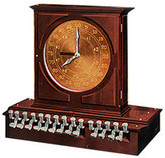History of Bar Restaurant Systems
History of Cash Register Systems
History of POS
Point of Sale systems have their roots in an 1870s Dayton, OH saloon. Deeming himself a "Dealer in Pure Whiskies, Fine Wines, and Cigars," owner/operator James Ritty had a successful business. But, like most business owners, he faced a growing issue of dishonest employees who frequently pocketed money from the customers instead of depositing it.
While on a steamboat trip to Europe, Ritty was intrigued by a mechanical device on the ship's propeller that tracked of the number of revolutions for maintenance purposes. Upon his return to Dayton, Ritty and his brother John began working to duplicate this idea to record cash transactions at the saloon with a mechanical device. In 1879, the Ritty brothers patented their invention as "Ritty's Incorruptible Cashier," or, as we know it today, the cash register.
The Ritty brothers opened a small factory in Dayton Ohio to manufacture their cash registers. Several years later, Cincinnati businessman Jacob H. Eckert bought the business from the Rittys and formed the National Manufacturing Company in 1881. He later sold it to John H. Patterson who continued making improvements to the cash register, including adding rolls of paper used to record each day's transactions.
Today’s POS systems allow restauranteurs and retailers
to operate every facet of their business
Over the years, more enhancements were made to the cash registers until the early 1970s, when the first computer-driven cash registers were introduced.
The first computer-driven cash registers were basically a mainframe computer packaged as a store controller that could control certain registers.
In 1980 Fred Ihrer the Innovetor , developed the concept of using networked PC's.
The Terminology POS, didn’t make its way into mainstream business until the late 1980’s.
This concept is what we
know today as POS.
Point of sale systems were the first to commercially utilize client-server technology, peer-to-peer communications, Local Area Network (LAN) backups, and remote initialization.
In the late 1980s, this software based on PC technology began to make its way into mainstream businesses.
Today, point
of sale systems are light years ahead of where they began. Today's POS systems are faster, more secure, and more reliable than their predecessors, and allow restauranteurs and retailers to operate
every facet of their business with a single, integrated point of sale system.



